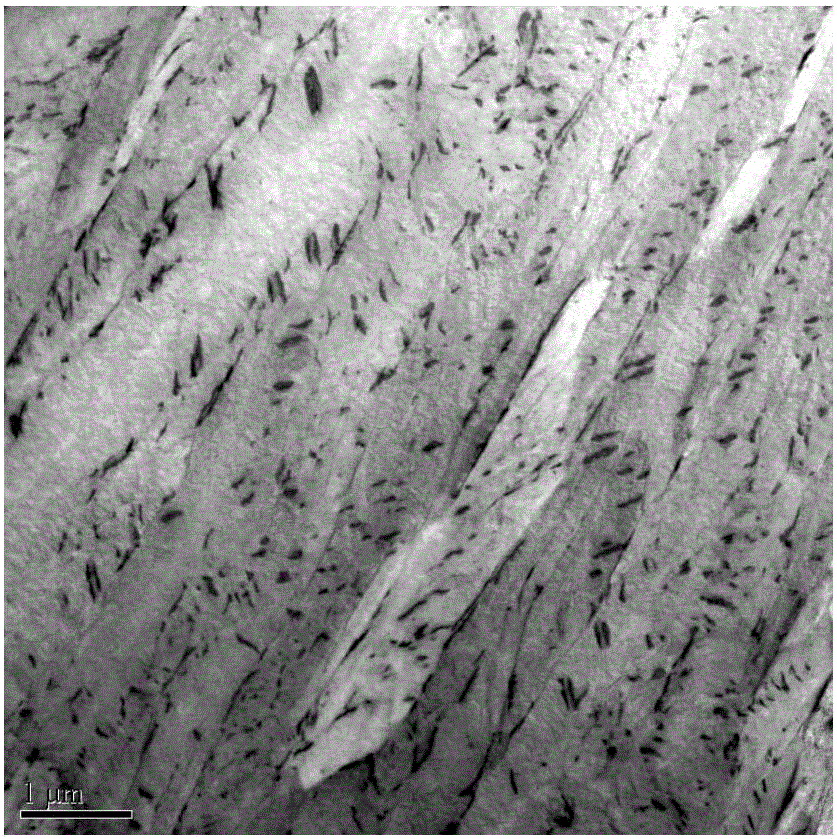Low-cost high-tenacity super wear-resistant steel and manufacturing method thereof
A high-toughness, low-cost technology, applied in the field of low-alloy wear-resistant materials, can solve the problems of low elongation and impact toughness of wear-resistant steel, insignificant surface hardening effect, and high Ni content, so as to improve hardenability, Improves wear resistance and reduces production costs
- Summary
- Abstract
- Description
- Claims
- Application Information
AI Technical Summary
Problems solved by technology
Method used
Image
Examples
Embodiment 1
[0037] The smelting of wear-resistant steel in this embodiment uses pure iron, scrap steel and ferroalloy, and is smelted in a vacuum heating furnace. After casting and forming, after high-pressure dephosphorization, the above process is carried out for hot rolling, and then heat treatment.
[0038] The low-alloy wear-resistant steel of this embodiment contains the following chemical elements: carbon 0.41%, Si: 1.60%, Mn: 0.22%, Ti: 0.20%, B: 0.001%.
[0039] In this example, the steel plate after rolling is heated from room temperature to 910°C at a heating rate of 12°C / S with the furnace, and then cooled to 100°C in a salt bath after being kept for 2.5H minutes, and then heated at a heating rate of 25°C / s from 100°C to 910°C. ℃ heated to 300 ℃ for 98 seconds, then kept at 160 ℃ for 6H minutes, and finally out of the oven and air-cooled to room temperature.
[0040] The mechanical performance test shows that the tensile strength of the wear-resistant steel is 1400MPa, the yi...
Embodiment 2
[0042] The low-alloy wear-resistant steel of this embodiment contains the following chemical elements: carbon 0.98%, Si: 3.3%, Mn: 0.25%, Ti: 0.22%, B: 0.003%.
[0043] After rolling, the steel plate is heated from room temperature to 850°C at a heating rate of 8°C / S with the furnace, cooled to 120°C in a salt bath after holding for 2.8H minutes, and then heated from 120°C to 281°C at a heating rate of 15°C / s Keep warm for 80 seconds, then keep warm at 250°C for 7H minutes, and finally take it out of the oven and air cool to room temperature.
[0044] The mechanical performance test shows that the tensile strength of the wear-resistant steel is 1480MPa, the yield strength is 1080MPa, the hardness value is 432HV, the elongation is 14.7%, and the impact toughness is 48J / cm2.
Embodiment 3
[0046] The low-alloy wear-resistant steel of this embodiment contains the following chemical elements: 0.55% carbon, 2.5% Si, 0.70% Mn, 0.30% Ti, and 0.005% B.
[0047] After rolling, the steel plate is heated from room temperature to 880°C at a heating rate of 20°C / S with the furnace, cooled to 249°C in a salt bath after holding for 3H minutes, and then heated from 249°C to 300°C at a heating rate of 20°C / s. 50 seconds, then keep warm at 180°C for 7.8H minutes, and finally take it out of the oven and air cool to room temperature.
[0048] The mechanical performance test shows that the tensile strength of the wear-resistant steel is 1502MPa, the yield strength is 1178MPa, the hardness value is 440HV, the elongation is 16.7%, and the impact toughness is 61J / cm2.
PUM
| Property | Measurement | Unit |
|---|---|---|
| tensile strength | aaaaa | aaaaa |
| yield strength | aaaaa | aaaaa |
| hardness | aaaaa | aaaaa |
Abstract
Description
Claims
Application Information
 Login to View More
Login to View More - R&D
- Intellectual Property
- Life Sciences
- Materials
- Tech Scout
- Unparalleled Data Quality
- Higher Quality Content
- 60% Fewer Hallucinations
Browse by: Latest US Patents, China's latest patents, Technical Efficacy Thesaurus, Application Domain, Technology Topic, Popular Technical Reports.
© 2025 PatSnap. All rights reserved.Legal|Privacy policy|Modern Slavery Act Transparency Statement|Sitemap|About US| Contact US: help@patsnap.com


